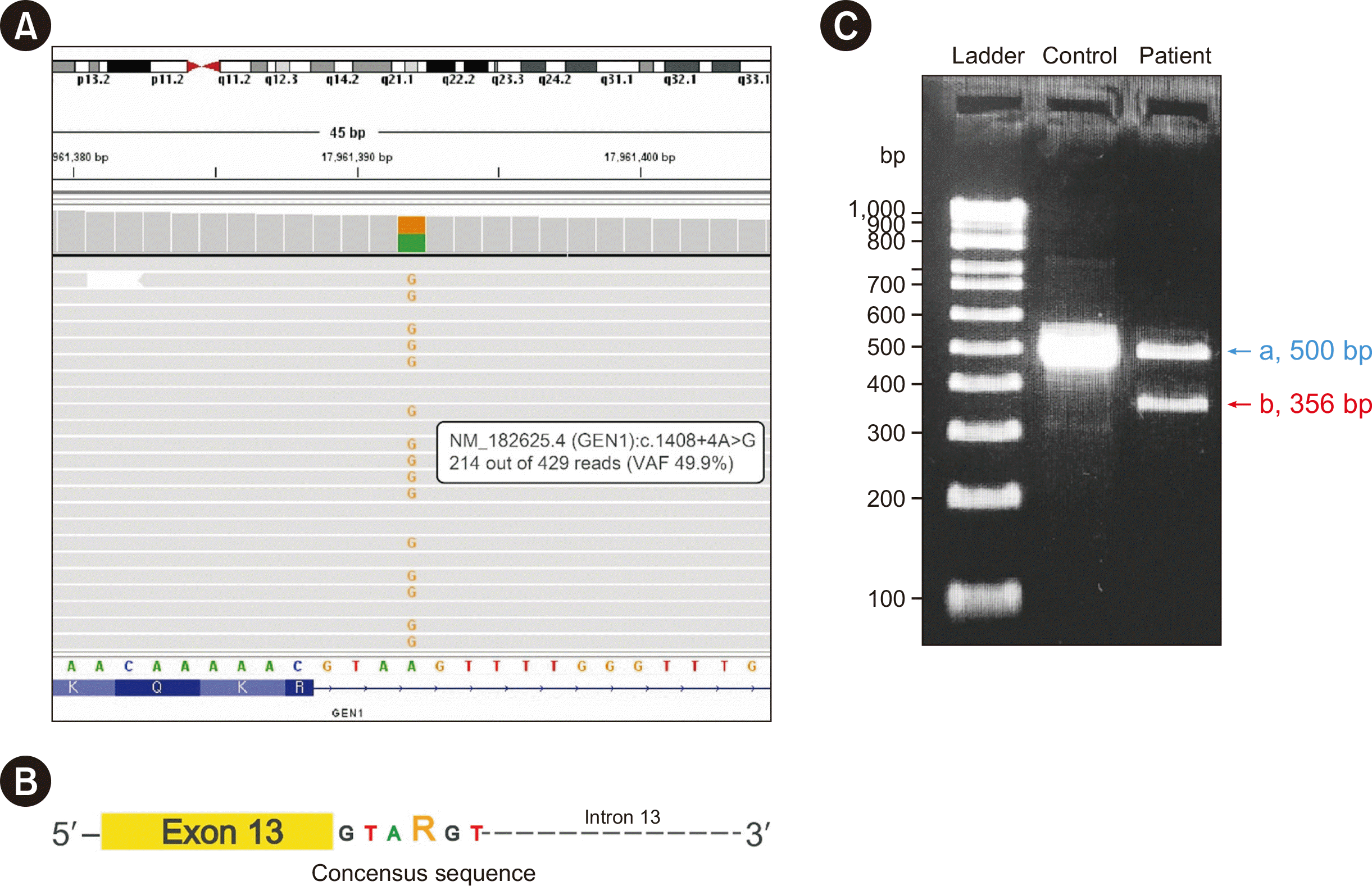Dear Editor,
In 2020, gastric cancer ranked fourth in incidence and mortality in Korea [
1]. The Laurén classification stratifies gastric cancer into intestinal and diffuse types. Although its genetic etiology is unknown, the intestinal type, which is more common than the diffuse type, is associated with inactivating mutations in cancer-predisposing genes, including
BMPR1A,
CDH1,
PTEN,
SMAD4,
STK11, and
TP53 [
2,
3]. Germline variants in
CDH1, which encodes the tumor suppressor E-cadherin, cause most of the hereditary diffuse-type gastric cancers. The Holliday junction resolvase GEN1 is a novel tumor suppressor that maintains genome integrity through homologous recombination-based DNA repair [
4,
5]. Only a few
GEN1 germline variants have been reported in breast and prostate cancer [
6,
7]. Given its contribution to cancer susceptibility,
GEN1 is included in recent next-generation sequencing (NGS) panels for determining hereditary cancer risk. We report an NGS-detected novel
GEN1 splice variant in a patient with diffuse-type gastric cancer. The splicing effect was confirmed by reverse transcription (RT)-PCR followed by Sanger sequencing.
A 48-yr-old woman with ulcerative lesion in stomach visited Asan Medical Center, Seoul, Korea, in November 2022. One month later, she underwent distal gastrectomy for advanced gastric cancer, which was histologically confirmed as diffuse-type gastric cancer, poorly cohesive carcinoma according to the 2019 WHO classification [
8]. The patient’s sister had lung cancer, but no other family history of cancer was reported.
After obtaining informed consent, targeted NGS testing was performed using a panel including 171 hereditary cancer-related genes (DxSeq library preparation kit; Dxome, Seongnam, Korea) and the MiSeqDx V2 sequencing kit on a MiSeqDx instrument (Illumina, San Diego, CA, USA). At a mean coverage depth of 571.7×, no significant variants were detected, except for pathogenic variants in
MSH3 and
GEN1. Given the autosomal recessive
MSH3 and autosomal dominant
GEN1 inheritance, the patient was presumed to carry the
MSH3 variant whereas the suspected variant, NM_182625.4 (GEN1):c.1408+4A>G (detected in 214 out of 429 reads; variant allele frequency, 49.9%) was considered a heterozygous and possible disease-related variant (
Fig. 1A and
1B).
 | Fig. 1
Genomic alterations in GEN1 detected using a targeted NGS panel, and agarose gel electrophoresis of RT-PCR products. (A) Integrative Genomics Viewer display of the c.1408+4A>G variant in GEN1 (B) Schematic diagram of the adenine (A) to guanine (G) substitution in the consensus sequence at a splice donor site in intron 13 (R denotes a purine [A or G]). (C) Agarose gel image showing only the normal splice product (a, 500 bp) in the control, and both aberrant (b, 356 bp) and normal splice products in the patient. A 500-bp amplicon was designed to partially cover exons 11 and 14 and fully cover exons 12 and 13 in the control using a target-specific primer set.
Abbreviations: NGS, next-generation sequencing; RT-PCR, reverse transcription-PCR; VAF, variant allele frequency.

|
The above intronic variant has not been reported in ClinVar, the Human Gene Mutation Database, or the general population and corresponds to PM2, according to the 2015 American College of Medical Genetics guidelines [
9]. Splice-site prediction algorithms, including Netgene2, AdaBoost (score: 0.9), and Random Forest (score: 0.7), predicted a splice-site change. The novel variant was tentatively classified as a variant of uncertain significance (VUS) because its splicing effect and clinical significance were not confirmed. RT-PCR and Sanger sequencing were performed to determine whether the splice donor-site change in the consensus sequence induced aberrant RNA splicing. Total RNA extracted from blood leukocytes of a control subject and the patient using the High Pure RNA Isolation Kit (Roche, Indianapolis, IN, USA) was reverse-transcribed into cDNA using the RevertAid First Strand cDNA Synthesis Kit (Thermo Fisher Scientific, Waltham, MA, USA). The cDNA was Sanger-sequenced using target-specific primers (5′-TGCTGGTACTTTTGACCCATT-3′ and 5′-ACTCCATGTTTGAATGCACAA-3′). Exon 13 skipping, which resulted in an in-frame 144-bp deletion in the RNA (r.1265_ 1408del), was detected (
Fig. 1C and
Fig. 2) and predicted to result in a 49-amino-acid deletion and a one-amino-acid insertion in the protein (p.Glu422_Arg470delinsGly) (
Fig. 2).
 | Fig. 2Schematic diagram of transcript analysis of the control and patient. (A) The c.1408+4A>G variant causes aberrant RNA splicing, resulting in the skipping of exon 13 (r.1265_1408del). (B) The r.1265_1408del mutant translates into a protein with a 49-amino-acid deletion and an insertion of a glycine in the deleted region (p.Glu422_Arg470delinsGly). Residues 422–464 within the deleted region are part of the chromodomain (residues 390–464). (C) Sanger sequencing chromatograms demonstrating heterozygosity for the variant that causes exon 13 skipping (forward sequence). 
|
For exon-skipping variants that maintain the reading frame, the evidence of PM4 is applicable [
10]. If the altered region is important for protein function, PM1 is also applicable [
9]. The chromodomain, which largely overlaps with exon 13 and consists of 75 amino acids (residues 390–464), is important for the catalytic activity of GEN1 and is highly conserved among eukaryotes. Experimental data have shown that chromodomain truncation leads to defective GEN1 function [
4]. Thus, exon 13 skipping likely has a detrimental effect on protein function because it results in the removal of >50% of the chromodomain (residues 422–464). Applying PM1, PM2, and PM4, the variant was reclassified from a VUS to likely pathogenic.
By demonstrating the splicing effect of variants, RT-PCR followed by Sanger sequencing helps determine the pathogenicity of intronic variants. However, without evidence of the crucial role of the relevant domain in protein function, PM4 alone rather than PM1 and PM4 should be applied to splice variants with preserved reading frames. In our case, the well-known function of the chromodomain allowed for the application of PM1.
In conclusion, RT-PCR followed by Sanger sequencing is useful for obtaining additional evidence in case of a suspected splice-site change. A comprehensive literature review of the functional aspect of the target gene is required to determine the clinical significance of in-frame splice variants. However, given the insufficient evidence for a gene–disease association for GEN1, the clinical significance of GEN1 variants should be interpreted carefully.
Go to :







 PDF
PDF Citation
Citation Print
Print



 XML Download
XML Download